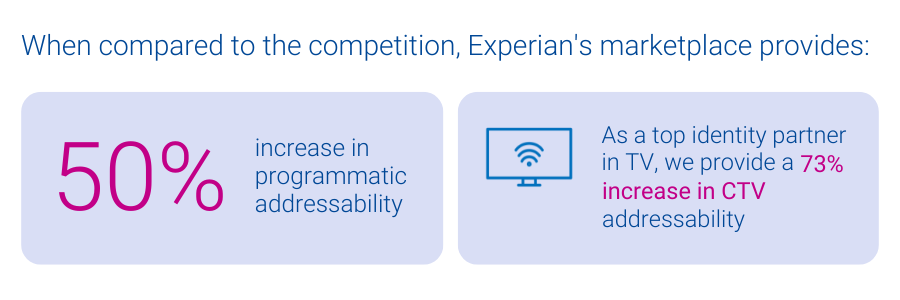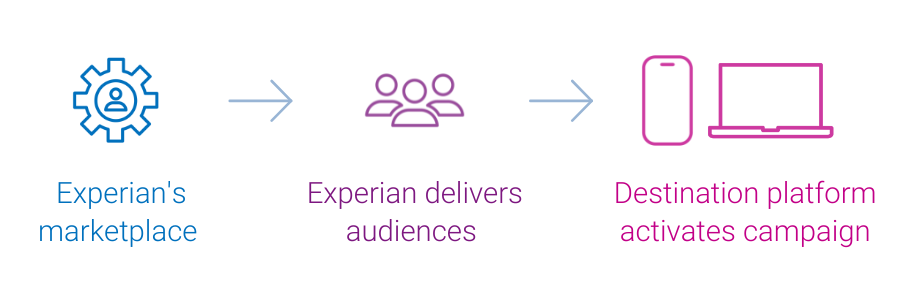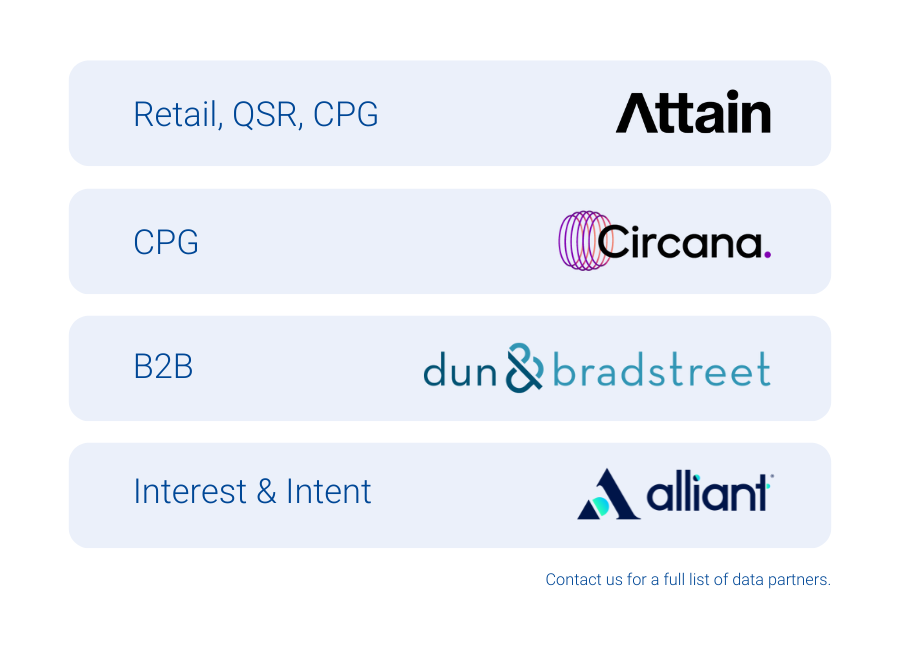
Following the success of our recent launch of Third-Party Onboarding, we are excited to introduce the Experian marketplace, a new addition to our portfolio of data-driven activation solutions.
Experian’s marketplace bridges TV operators, programmers, supply partners, and demand platforms with top-tier third-party audiences across retail, CPG, health, B2B, and location intelligence. Easily activate premium audiences from leaders like Attain, Alliant, Circana, and Dun & Bradstreet – driving precise, efficient consumer reach.
“Experian has been a longstanding partner of DISH Media, and we’re excited to be an early adopter of their marketplace which leverages the foundation of their identity solutions to ensure maximum cross-channel reach as we look to expand the breadth and depth of data we use for addressable TV.”
Kemal Bokhari, Head of Data, Measurement & Analytics, DISH Media
As privacy regulations evolve and traditional identity signals shift, many activation platforms face declining addressability. This impacts their ability to effectively reach consumers, which is critical to staying competitive. Experian’s marketplace, powered by our identity graphs which include 126 million households, 250 million individuals, and 4 billion active digital IDs, enables audiences to be easily activated and maintain high addressability across display, mobile, and connected TV (CTV) channels.


Benefits of Experian’s marketplace
- Enhanced addressability and match rates: All audiences delivered from our marketplace benefit from our best-in-class offline and digital identity graphs, which ensure addressability across all channels like display, mobile, and CTV. Unlike other data marketplaces, Experian ensures all identifiers associated with an audience have been active and are targetable, improving the accuracy of audience planning.
- Simplified audience planning and distribution for TV Operators: TV operators can build custom audiences matched directly to their subscriber footprint and distribute them across all advanced TV channels (data-driven linear, addressable, digital, and CTV) for maximum impact.
- Diversification within the data marketplace ecosystem: With the recent departure of Oracle’s advertising business, the optionality for buyers and sellers to connect with third-party data has become increasingly limited. With Experian marketplace, we’re excited to offer a new solution to the market that ensures data-driven targeting can continue to take place at scale.
- Lower activation costs: Experian’s marketplace offers transparent, pass-through pricing with no additional access fees, enabling partners to maximize their earnings while reducing costs.
- Audience diversity and scale: Platforms can access a broad range of audiences across top verticals from our partner audiences, which can be combined with 2,400+ Experian Audiences. This offers the flexibility, reach, and scale necessary to effectively execute advertising campaigns.
- Remove compliance concerns: Experian’s rigorous data partner review ensures available audiences comply to all federal, state and local consumer privacy regulations.
“Circana and Experian have enjoyed a deep partnership for over a decade. We are exceedingly excited to extend our partnership and be an early adopter and launch partner of the Experian data marketplace. This additional capability will enable the ecosystem to more easily access Circana’s purchase-based CPG and General Merchandise (for example Consumer Electronics, Toys, Beauty, Apparel etc.) audience segments to drive performance outcomes across all media channels.”
Patty Altman, President, Global Solutions, Circana

“Capturing the attention of target audiences across channels is critical for marketers navigating an increasingly connected digital world. We are excited to be an exclusive provider of B2B solutions within Experian’s marketplace, helping brands and media agencies to accelerate their reach, addressability and targeting capabilities across TV, mobile and connected TV channels.”
Georgina Bankier, VP of Platform Partnerships at Dun & Bradstreet
Better connections start here: Experian’s marketplace
Experian’s marketplace, easily accessible from our Audience Engine platform, brings unparalleled addressability, enabling our clients to reach more relevant consumers and increase revenue.
If you’re interested in learning more about Experian’s marketplace or becoming an active buyer or seller in our marketplace, please contact us.
Latest posts

Globalization affects retailers in a number of ways. Complying with commercial laws wherever they have brick-and-mortar stores is one such impact. Navigating through privacy rules that impact e-commerce efforts is another. There is one blind spot in particular that deserves attention — sending shopping cart abandonment emails. I am often asked, “How are abandonment emails treated under the CAN-SPAM Act? Canada’s stringent Anti-Spam Law (CASL)?” “Can I even send abandonment emails to my Canadian customers?” What are cart abandonment emails? But let’s back up… What is an ‘abandonment’ email anyway? In the email space shopping cart abandonment refers to a particular type of automated mailing used to re-engage an online customer. The most common example is one where a retailer notices that a customer has left an item sitting in their shopping cart, and proceeds to send a reminder with a coupon to complete the order. To fully understand privacy compliance pitfalls with this technique, in the U.S. and beyond, we need to unpack what happens before the abandonment email is sent. Email marketing shopping cart abandonment compliance Abandonment messages are almost always ‘commercial’, particularly if they incentivize a shopper to complete their purchase. In compliance parlance, we call this encouraging the continuation of a commercial activity. In contrast, an order confirmation typically provides factual information about a commercial activity. Under most anti-spam laws, particularly under CASL, marketers need to ensure abandonment messages are not unsolicited. Triggering should account for: Appropriate consent covering email marketing to new or ongoing online relationships. Scrubbing the customer’s email address against your unsubscribe/suppression lists before sending a solicitous message. (This is true under any anti-spam law.) For more information about CASL-compliant consent record keeping and related best practices, you can navigate to the Canadian Radio-television and Telecommunications Commission. Maintaining compliance with online tracking Abandonment emails rely on online retailers tracking their customers’ activity on their websites and tying online behavior back to the email addresses using the same behavioral targeting technologies as those used to deliver Interest Based Ads. This jump across engagement channels to remarket to customers can raise privacy concerns, so online retailers need to pay attention to their privacy compliance obligations. Cross-channel marketing privacy protections Guidance covering privacy policies and practices issued by the Federal Trade Commission are informative and I encourage you to review these with your law department. If you operate outside the U.S., privacy protection laws like Canada’s Personal Information Protection and Electronic Documents Act (PIPEDA) may set out additional obligations with your cross-channel marketing efforts. PIPEDA’s definition of commercial activity, which includes remarketing Privacy Commissioner’s findings under PIPEDA in relation to remarketing Privacy Commissioner’s guidance on online behavioral advertising, the technology of which informs triggered emails Under PIPEDA and similar international privacy regimes, cross-channel marketers will need to (i) clearly and conspicuous inform website visitors that their online activities may result in personalized marketing, (ii) offer a way to opt-out of such tracking, and (iii) obtain individuals’ prior express consent with tracking involving sensitive personal information such as health data How to manage cross-channel marketing compliance risks As privacy protection regimes around the world continue to mature and absorb rules covering marketing, online retailers need to start adding new vocabulary to their privacy compliance lexicon. For example, shopping cart abandonment efforts produce ‘cross-channel re-marketing campaigns triggered by an identifiable individual’s online behavior.’ While this is a mouthful to say, viewing your engagement efforts through this lens will help you manage compliance risks. Experian can help you navigate compliance risks Our privacy-first approach to data is trusted across industries around the world. As a leader in the industry, we are here to help you leverage the power of data while maintaining the highest standards of consumer privacy compliance and legal guidelines. With almost 30 years in business, we are here to help you confidently create and launch data-driven marketing strategies. Contact us today to get started! Please note: Cross-Channel Marketing does not give legal advice on electronic marketing regulations or privacy laws. To mitigate risk to your business, please consult with your legal counsel on the law and your corporate policy.

Partnership combines customer connections and cross-device scale to deliver more strategic customer insights NEW YORK AND CHICAGO — March 16, 2017 — Signal, the global leader in customer identity, today announced a partnership with Tapad, now part of Experian and the leading provider of unified, cross-screen marketing technology solutions. This global integration extends device connectivity for Signal’s clients across North America, APAC and EMEA by leveraging Tapad’s proprietary Device GraphTM. With Signal’s Customer Identity Solution, brands benefit from more visibility of known customers, lower costs to reach those customers and decreased expenses and data loss that often results from using multiple vendors. Integrating with Tapad’s Device Graph, which connects billions of devices, enables Signal clients to build an even broader view of their known customers across multiple devices. This integration combines Signal’s customer identity scale with Tapad’s device scale to expand the reach of addressable media channels and enhance customer journey insights across touchpoints. Tapad and Signal were able to drive incremental device connections for more than 65 percent of customer profiles, linking an average of 6.8 browsers and devices per customer. With this combined data set, Signal clients can expand their authenticated view of a customer to all associated devices and realize more strategic insights into their high-value users. The partnership also allows Signal’s clients to integrate in real-time with Tapad’s media platform, Unify. This proprietary technology enables advertisers to make real-time activation and buying decisions with maximum scale, as well as automated reporting and measurement. “Continuously recognizing customers across devices instantly and in a privacy-safe way is essential for marketers to stay competitive,” said Marc Kiven, founder and CRO of Signal. “We are thrilled to enter this unique, global partnership with Tapad, enabling our clients to access their technology and more effectively reach customers in real-time and at scale.” “Being able to leverage a persistent view of customer connections across devices is a huge challenge for brands,” said Pierre Martensson, SVP and GM of Tapad’s global data division. “With Tapad, Signal is now able to connect with the billions of existing data points in our device graph to help clients better understand customer behavior and realize even stronger customer engagement.” Contact us today

Early successes include revenue increases, global partnerships and fundraising NEW YORK, March 16, 2017 /PRNewswire/ — Tapad's entrepreneurial mentorship initiative, the Propeller Program, has seen extremely positive results since it began in September 2016. The five early-stage startups selected from Norway have gained momentum in establishing a U.S. presence. Tapad, now a part of Experian, is the leader in unified cross-device marketing technology. The company was acquired by the Telenor Group in 2016. Among the successes within Propeller: Xeneta, the leading ocean freight price comparison platform and contracted rate database, has raised an additional $12M in funding since beginning the Propeller Program. Before the end of 2016, the company had exceeded its revenue expectations by nearly 30 percent, proving the European-focused business could succeed in the American market. "Aside from directly impacting our revenue, the Propeller Program has provided us with incredible access to a countless number of external resources, including subject matter experts from the fields of fundraising, public speaking, corporate structuring and immigration law," said William Di Ieso, GM of North America for Xeneta. "We remain extremely grateful for the opportunity and exposure the program has provided for Xeneta." Bubbly, an in-store real-time engagement tool for non-buyers, now has clients on four continents. After only a few months in the U.S. market, Bubbly has signed deals with one major retail brand, one major toy manufacturer and a major global consulting firm. The Propeller Program has also opened doors for greater opportunities in Scandinavia and EMEA. After an introduction to Telenor Group's President and CEO Sigve Brekke, Bubbly is currently piloting its IoT kiosk with the company. "The mentoring sessions have been very valuable and have given us guidance as to how to best enter the U.S. market," said Marianne Haugland Hindsgaul, Bubbly CEO and co-founder. "Learning to do business in the U.S. is not something you can necessarily learn from a book. The most impactful lessons are based on real-world experience, and that is what the Propeller Program has given us." BylineMe, a marketplace for freelancers, publishers and brands to connect for content creation and distribution services, has built an extensive network of potential clients and investors. The company has tested its product in the U.S. market and gained valuable feedback for further development. Eventum, a property-sharing group that digitally assists in securing venues for meetings and corporate events, has closed a seed round of funding for nearly $1M. Eventum has also made key hires in the areas of business development and engineering. Socius, under the influence of Tapad, pivoted into the ad tech space, positioning itself as "a social native ad platform" for digital publishers. The company has attracted top talent to begin building out its U.S. business development and sales divisions. As a result, Socius has signed a host of premium publisher partners to validate its exciting new direction. "It is so rewarding to be able to support these Norwegian startups in a meaningful way," said Are Traasdahl, CEO and founder at Tapad. "Mentor relationships are critical for strategic growth, and I am proud to be able to pay forward the experiences I have gained as an entrepreneur. To me, the Propeller Program is a shining example of the magic that can happen when Norwegian innovation meets American opportunity." Contact us today!